I’ve been sharing a bit of progress with you lately on this voided monogram worked with cotton floche. It’s a fun project, and I can’t wait to share the Whole Thing with you!
There’s more to it than meets the eye, too. As soon as the stitching on the samples is complete, I’ll be finishing them into something useful. It’s always nice to be able to finish small embroidery things into something useful, isn’t it?
And there’s also a non-monogram design that goes with this set. But more on that project a little later!
Today, I’ll show you two approaches to the same design, one worked in color and the other in white. You’re never limited in your interpretation of an embroidery design, after all!
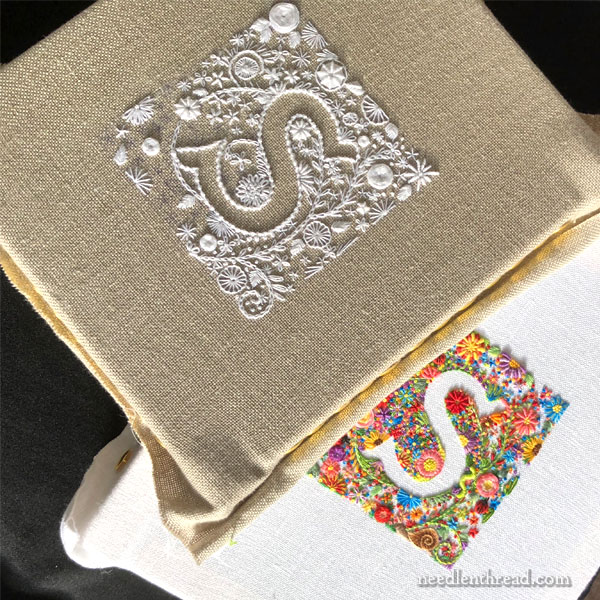
Same design, two approaches!
The difference in interpretation between the sample embroidered with cotton floche and the sample embroidered with whitework threads (in this case, coton a broder in size #20 and #25) is not just in color. We’ll look at what else is different about the stitching, below.
Just so you know, the designs are both the same size. (More about size below, too!)
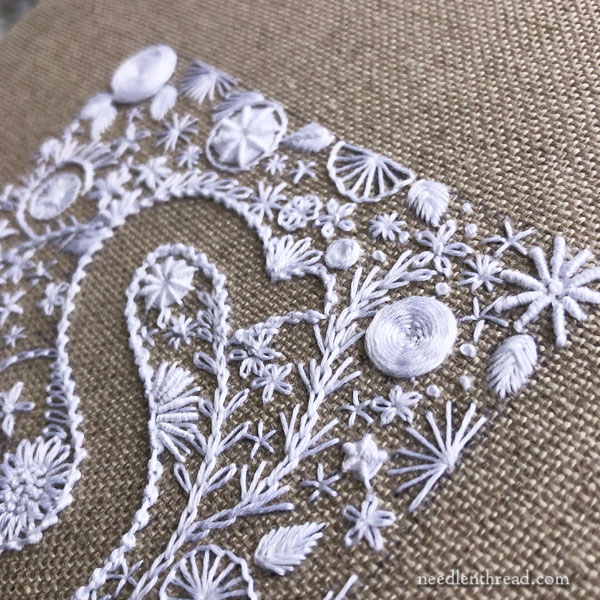
I happen to love the combination of white on a natural colored linen. But I also like all-white embroidery on any linen that provides a good contrast. I’d love to play with this on a vibrant blue and on a sea-green of sorts. I think it would also look great on a coral or salmon. I think I need to go on a fabric hunt!
In any case, this linen is a 30-count linen called Sunflower Seed from Access Commodities, available through Needle in a Haystack and other fine needlework shops that carry products from Access Commodities.
It is not super well-suited for surface embroidery on its own, but I liked the color and I like the fabric. To work with surface embroidery well, it needs to be backed by another fabric. I’ve got cotton batiste behind it, because that’s what I had on hand. A cotton muslin would work, too.
If you’re embroidering a free-style, non-counted project on lower count (like 30) even-weave linen, in order for line stitches to flow very smoothly and in order for denser areas of stitching to have something to grip into, a backing fabric helps tremendously. Otherwise, you might find yourself forced to the grid of the even-weave fabric, which would detract from the whole layout and flow of the design.
You can read more about backing your embroidery ground fabric here. It’s not always necessary, but sometimes, it is!
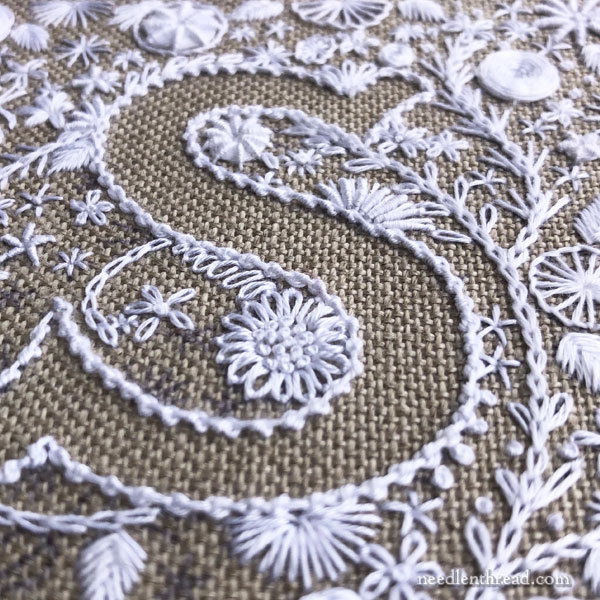
There are two differences in the approach to the stitching on this design, when working with the all-white threads.
The first is that the background is not as densely stitched as the colored version. In the color version, the dense stitching fills the whole ground fabric, except where the S is voided.
And this leads to the second difference: the S is outlined in the whitework version, because otherwise, it would not stand out as clearly.
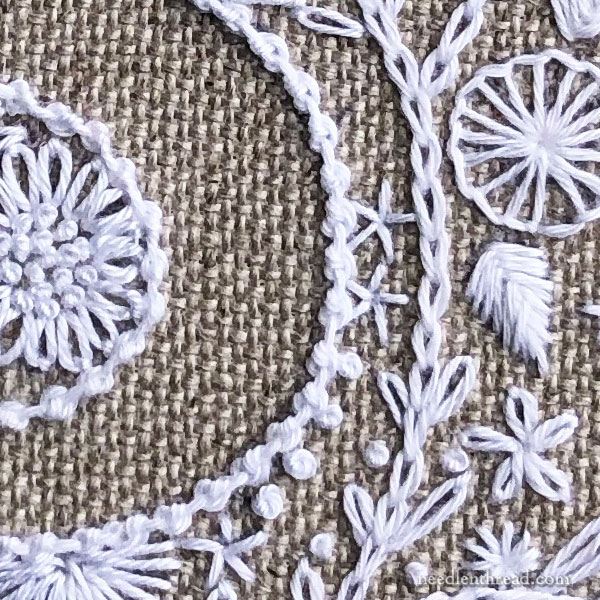
With all-white embroidery, texture is essential, and this design provides lots of texture. The embroidery, even if it is void of color, is not boring! The various textures keep it interesting and fun to do.
The S is outlined with Palestrina stitch (speaking of texture). It’s a wonderfully textured, knotted line stitch.
I made the mistake of working the letter outline after much of the background was already embroidered. Bad approach! The Palestrina stitch is one of those “pass under and through” sort of stitches, which makes for a sticky situation if there’s a lot of stitching surrounding it. The needle tends to aim for every stitched element with obviously wicked and nefarious intentions of snagging them!
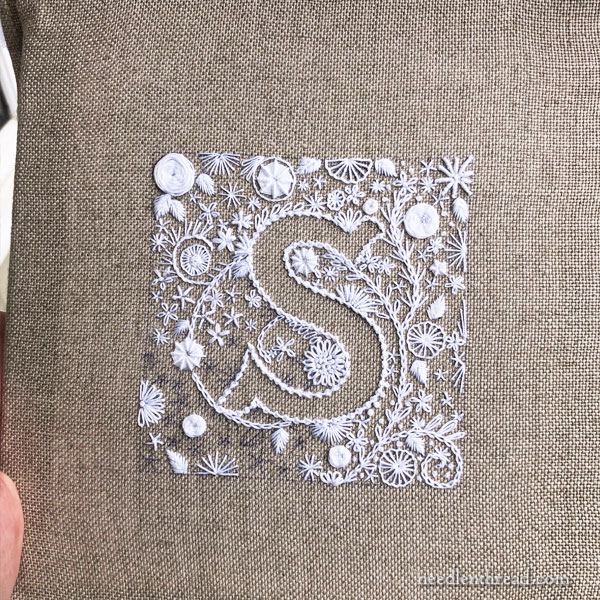
This weekend when I was chatting with one of my sisters, I found out that the size of these designs is really not coming across well in the photos. She had the impression the designs were quite large.
So I shuffled through my photos this morning, to see if I could find any that might give a sense of scale. The photo above has the edge of my thumb in it, on the lower right. That’s the closest I’ve got for now, but in the future, I’ll try to do better about including something to judge the size against!
The designs are 3.5″ square.
So that’s a little more progress on stitching samples!
Over the next few weeks here on Needle ‘n Thread, we’ll look at quite a few stitchy things. A little thread talk – I’ll show you another new-to-me thread – and another book, plus I’ll be reviewing an embroidery kit that would work great for folks wanting to try a little silk and goldwork on a small design. I’ve got a tutorial and some more stitching tips in the line-up, too. And I might even show you my new power tool that has taken up permanent residence in my embroidery studio. I never knew I could love a power tool so very much!
Happy Monday! I hope your week is off to a marvelous beginning!







Oooh, I love the white on natural. Not that I don’t love the colorful version too, but this is suitable for different applications.
I love these! I have been looking for a small project to make for gifts for some special friends of mine, and I think the whitework initials would be the perfect gift.
Thank you so much for your inspiration and tips and information. You are the best.
I have just been considering a “voided” or negative space approach to a piece I’m working on! This is so timely! I appreciate seeing both approaches, and I’d forgotten about palestrina stitch! It’s so lovely. Might have to use that.
Thank you!
Miniature painters often include a penny for size comparison. 😀
If you are going to add something to your photos to show the relative-size of the design, can I put in a plea for a ruler or tape-measure please? As a Brit in the U.K. I can relate to your thumb, but when North Americans put a coin to show size it’s not a great help. 🙂 Thanks Mary! (And I LOVE your all-white projects too!)
I like your idea of including something in your photographs to indicate the size of the project, but please don’t use a coin. For those of us who aren’t American and who do not travel, coin sizes are another unknown quantity.
I sometimes fall in love with even-weave fabric like the one you are using, but I have a “fix” for the problems it makes for surface stitching. I wash it and dry it by machine. Once linen has soaked in hot water, has been rinsed and spun and then put in a dryer (with something like jeans or percale sheets that have hard surfaces and do not shed), it is a changed fabric. It might be thinner, but the threads have closed up so that it is better to holds stitches that do not use a grid. If I remember to catch the fabric before it completely dries, I can lay it out flat and let it continue to dry that way. Or I can wet it, leave it in the refrigerator for a day, and iron it to give it a crisp finish again. Even after all this, I still line everything I stitch, because I need a place on the back where I can “park” my threads when I start and end things. The heavier the threads I use, the heavier the backing. Old linen napkins that are stained are perfect for this– some are washed to great thin-ness, others (particularly damask) are still heavy and keep the perles happy by giving them something to bite into and lay in place. But this is just my way of working. I wonder if there are others who use even-weave fabrics for projects other than counted work?
I too am often thinking your projects are larger than actual size and would love something for size comparison included in at least one photo of a project. How much photo editing do you do – would it work to add dimensions to the photo?
Both of these are lovely, but have such different moods. The multi-colored one has such joyful “kick up your heels dancing in a meadow” attitude, the white on natural has “mind yer manners, this ain’t no place for foolishness” attitude.
I love both of them, Mary. The white is always so traditionally classy to me, but I love color one too. I’d say it’s a draw because I couldn’t pick just one. I need to find the time to draw out a design and leave it in my 15 min. basket. So lovely!! And I like the size too. It would make a great book or journal cover. Thanks for the inspiration.
I love both versions Mary, but I am oh so drawn to the textures of the white version! I find it fascinating how it seems to display the different character of the stitch types you’ve used together. I really do like this and particularly the play element with the stitching choices. :0
Please tell me the name of this gorgeous pattern and where I can buy it. Thank you ‼️
Hi, JNET – I haven’t yet released the designs for this alphabet, but they are coming soon! Just keep an eye on the website here!
Looking at your work gives me joy. Thanks for sharing.
I look forward each day to your posts. I am a terrible embroiderer, but don’t let that stop me from following all your ideas
I love this project.
Is this needle case pattern available with other initials?
Thank you,
Linda Willis
Not right now, but something will be coming out in the not-too-distant future.
I hope I have not missed this stunning needle case design. Half way through the needle case that will match beautifully. Love the small stitch snippets.